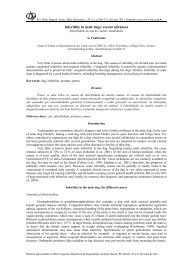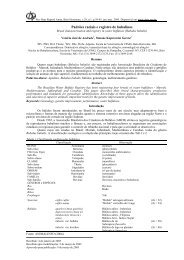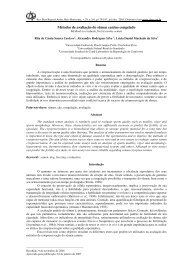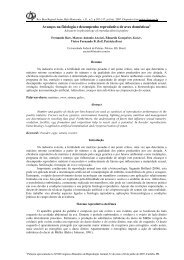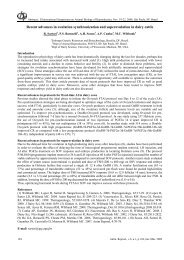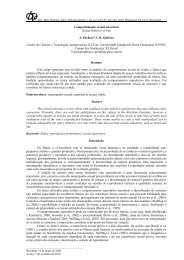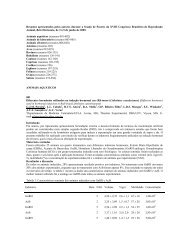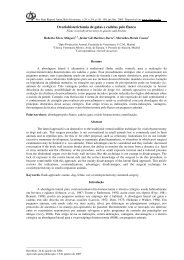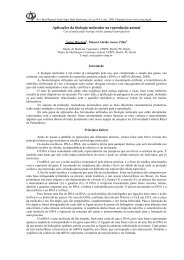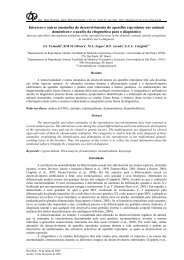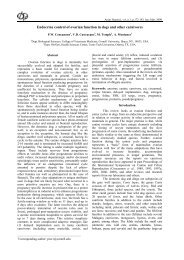Sanitary requirements for bovine gametes and embryos in ... - CBRA
Sanitary requirements for bovine gametes and embryos in ... - CBRA
Sanitary requirements for bovine gametes and embryos in ... - CBRA
Create successful ePaper yourself
Turn your PDF publications into a flip-book with our unique Google optimized e-Paper software.
Ponsart <strong>and</strong> Pozzi. <strong>Sanitary</strong> <strong>requirements</strong> <strong>for</strong> <strong>gametes</strong> <strong>and</strong> <strong>embryos</strong>.Enzootic Bov<strong>in</strong>eLeucosis (EBL)*Foot <strong>and</strong> MouthDisease (FMD)Infectious Bov<strong>in</strong>eRh<strong>in</strong>otracheitis/Infectious PustularVulvovag<strong>in</strong>itis *(IBR-IPV)Lumpy Sk<strong>in</strong> Disease*(LSD; caused bygroup III virus, typeNeethl<strong>in</strong>g)• donor bull resident at the time of semen collection <strong>in</strong> an EBL free herd; <strong>and</strong> if lessthan 2 years of age, the bull came from a serologically negative ‘uter<strong>in</strong>e’ dam; orbull subjected to diagnostic tests <strong>for</strong> EBL on blood samples on two occasions withnegative results (first test at least 30 days be<strong>for</strong>e <strong>and</strong> the second test at least 90 daysafter semen collection).FMD free countries• with no cl<strong>in</strong>ical signs of FMD on the day of collection of semen <strong>and</strong> <strong>for</strong> thefollow<strong>in</strong>g 30 days;• animals kept <strong>for</strong> at least 3 months prior to collection <strong>in</strong> an FMD free country or zonewithout vacc<strong>in</strong>ation or a FMD free compartment;FMD <strong>in</strong>fected countries• no cl<strong>in</strong>ical sign of FMD on the day of collection of the semen;• animals kept <strong>in</strong> an establishment where no animal had been added <strong>in</strong> the 30 daysbe<strong>for</strong>e collection, <strong>and</strong> that FMD has not occurred with<strong>in</strong> 10 kilometers <strong>for</strong> the 30 daysbe<strong>for</strong>e <strong>and</strong> after collection;• have not been vacc<strong>in</strong>ated <strong>and</strong> were subjected, not less than 21 days after collectionof the semen, to tests <strong>for</strong> antibodies aga<strong>in</strong>st FMD virus, with negative results; or hadbeen vacc<strong>in</strong>ated at least twice (last vacc<strong>in</strong>ation not more than 12 <strong>and</strong> not less thanone month prior to collection);• no other animal present <strong>in</strong> the artificial <strong>in</strong>sem<strong>in</strong>ation center has been vacc<strong>in</strong>atedwith<strong>in</strong> the month prior to collection;• the semen subjected, with negative results, to a test <strong>for</strong> FMDV <strong>in</strong>fection (if donoranimal vacc<strong>in</strong>ated with<strong>in</strong> the 12 months prior to collection); stored <strong>in</strong> the country o<strong>for</strong>ig<strong>in</strong> <strong>for</strong> a period of at least one month follow<strong>in</strong>g collection, <strong>and</strong> that dur<strong>in</strong>g thisperiod no animal on the establishment showed any sign of FMD.• Fresh semen: IBR/IPV free herd at the time of collection of the semen;• Frozen semen: IBR/IPV free herd at the time of collection of the semen; or donoranimals <strong>in</strong> isolation dur<strong>in</strong>g the period of collection <strong>and</strong> <strong>for</strong> the 30 days follow<strong>in</strong>gcollection <strong>and</strong> subjected to a diagnostic test <strong>for</strong> IBR/IPV on a blood sample taken atleast 21 days after collection of the semen, with negative results; or if unknownserological status of the bull or positive serology, an aliquot of each semencollection subjected to a virus isolation test or PCR, per<strong>for</strong>med <strong>in</strong> accordance withthe TM, with negative results.• from LSD free countries (cattle <strong>and</strong> water buffaloes): no cl<strong>in</strong>ical sign of LSD on theday of collection of the semen; kept <strong>for</strong> at least 28 days prior to collection <strong>in</strong> an LSDfree country;• from countries considered <strong>in</strong>fected with LSD: no cl<strong>in</strong>ical sign of LSD on the day ofsemen collection (SC) <strong>and</strong> <strong>for</strong> the follow<strong>in</strong>g 28 days; kept <strong>in</strong> the export<strong>in</strong>g country<strong>for</strong> the 28 days prior to SC, <strong>in</strong> an establishment or AI center where no official caseof LSD dur<strong>in</strong>g that period, <strong>and</strong> establishment or AI center was not situated <strong>in</strong> anLSD <strong>in</strong>fected zone; <strong>and</strong> either: vacc<strong>in</strong>ated aga<strong>in</strong>st LSD (28 to 90 days be<strong>for</strong>e SC <strong>and</strong>thereafter vacc<strong>in</strong>ated annually); or tested with negative results us<strong>in</strong>g a serumneutralization test (SNT) or an <strong>in</strong>direct enzyme-l<strong>in</strong>ked immunosorbent assay(ELISA) <strong>for</strong> LSD on the day of first or up to 90 days after last SC; or stableseropositivity (not more than a two-fold rise <strong>in</strong> titre) on paired samples (tested sideby side) to <strong>in</strong>direct ELISA or SNT carried out <strong>in</strong> quarant<strong>in</strong>e, 28-60 days apart (firstsample taken on the day of first SC).Trichomonosis* • donor animals never been used <strong>for</strong> natural service; or have only mated virg<strong>in</strong>heifers; or kept <strong>in</strong> an establishment or AI center where no case of trichomonosis hasbeen reported; animals subjected to a direct microscopic <strong>and</strong> culture of preputialspecimens with negative results.*For each listed disease, Veter<strong>in</strong>ary Authorities of import<strong>in</strong>g countries should require the presentation of an<strong>in</strong>ternational veter<strong>in</strong>ary certificate attest<strong>in</strong>g that the semen was collected, processed, <strong>and</strong> stored <strong>in</strong> con<strong>for</strong>mity withthe provisions of Chapters 4.5 <strong>and</strong> 4.6. **Compartment means an animal subpopulation conta<strong>in</strong>ed <strong>in</strong> one or moreestablishments under a common biosecurity management system with a dist<strong>in</strong>ct health status with respect to aspecific disease or specific diseases <strong>for</strong> which required surveillance, control, <strong>and</strong> biosecurity measures have beenapplied <strong>for</strong> the purpose of <strong>in</strong>ternational trade.Anim. Reprod., v.10, n.3, p.283-296, Jul./Sept. 2013 289



